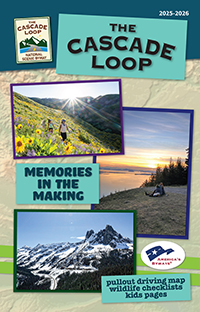This article was written by local photographer Mukul Soman. Take a look at these amazing photographs and enjoy some tips from a pro!
The Skagit Valley has been one of my favorite places to photograph bird life in Washington state. Winter season is one of the best times of the year to view various species of wintering birds, especially raptors. Every year during the months of December to March, the Valley becomes home to wintering ducks, geese and swan, which all provide plenty of feeding opportunities for aerial predators like raptors. Of all the areas in the Valley, the Samish flats have been my favorite go-to spot to view raptors in action.
This area has been quite amazing as I have had the opportunity to watch and photograph a wide variety of raptors including Bald Eagles, Red tailed Hawks, Rough-legged Hawks, Northern Harriers, Short eared Owls, and Barn Owls. I usually go out looking for raptors about 3 hours before sunset. Days with mild wind are preferred as owls and hawks find it difficult to pick up the vibrations made by small rodents when there is a lot of rustling of the foliage, from wind. It also helps to not wear any clothing that’s too bright, as that could alarm the birds and they might not approach close enough for you to take photographs. I find that the most successful images of mine were created through hours of waiting in one spot and letting the birds get used to your presence and then after a while, they accept you as part of the environment and start ignoring your presence. I also pay a lot of attention to the angle of light falling over the flats and try to find vantage points where the key light from the sun and the fill light from the sky are distributed evenly as much as possible. This gives a lighting ratio that can make for a RAW file with great detail and inherent contrast, which can be processed to your artistic taste later.
Below are some of the images that I have photographed in the area. All images were ethically photographed at a respectful distance from the birds, without causing any disturbance to their natural behavior and habitat.
A beautiful view across the flats with 2 Short-eared owls perched upon sign poles. The distant mountains and atmosphere along with some dusting of snow on the ground made for a spectacular scene.
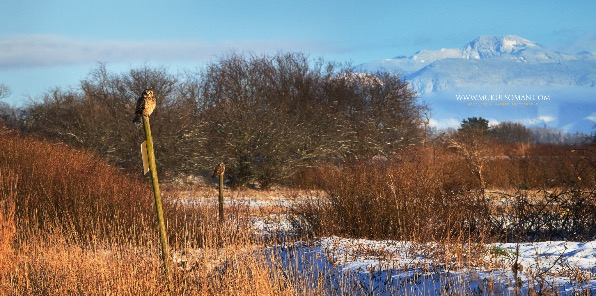

One of the most loved winter predatory residents of Samish Flats is the Short-eared Owl. Short-eared Owls lives in open terrain, such as prairies and marshes. They are often active during daylight, especially in the evening, like in this image that was taken at sunset. These beautiful raptors are facing habitat loss across the southern parts of the United States, but can be seen regularly here in the flats during winter. That is all the more reason for us to protect these lands that they call home to prevent further loss of habitat.
Come to mama little mouse” – seems to be what is going on in this short eared owl’s mind!

Short-eared owls like most owl species have super sharp talons and they are such wonderful personalities! They have feathered feet to protect them from cold weather and also serve to sense contact with prey, and to protect against prey that might bite when seized.
A Short-eared Owl sitting in beautiful light at Samish Flats. The whole scene looked like a painting!

Short-eared Owls appear particularly sensitive to habitat loss and fragmentation, as they require relatively large tracts of grassland and are ground-nesters, making them susceptible to the increased predation pressure that is typical within fragmented habitats and near rural developments.
Barn owl showing off those mighty talons.

A female Northern Harrier hawk taking a moment between hunting for voles.

Northern Harriers have an owl-like facial disk that allows them to hunt by sound as well as by sight. Their round faces act like a dish to listen to sound waves emitted by their prey.
These raptors are so pretty especially when the evening light hits their feathers at just the right angle. The warmth of that light transforms them into mythical firebirds! I mean look at those fiery feathers!
An adult male Northern Harrier Hawk is other-wise known as the “Grey Ghost”. I have always wondered where that name came from, so I did some research. Some say it comes from the color of their plumage, others says it’s because of how quick they are when they appear and vanish in to the distance, others say it’s because they are so quiet. Possibly a mix of all three maybe?

A Rough legged Hawk in flight against a white wintery sky.

The name “Rough-legged” Hawk refers to the feathered legs. Did you know that the Rough-legged Hawk, the Ferruginous Hawk, and the Golden Eagle are the only American raptors to have legs feathered all the way to the toes?
An almost mature Bald Eagle flying through a spotlessly white sky.

Once fully mature, the white spots on a Bald Eagle’s dark feathers will fully disappear and the feathers on the head turn all white. Bald eagles can be seen at the Samish flats year round, however their numbers rise considerably in winter. They compete with the owls and the hawks for food and can be seen participating in violent aerial dogfights often.
I was super lucky to come across this Red-tailed hawk in the middle of consuming a small songbird. This moment was so primitive and looked straight out of a Jurassic Park movie! Red-tailed hawks usually swallow small mammals whole but they pick apart birds before ingesting them, but this one decided to just swallow its prey whole.
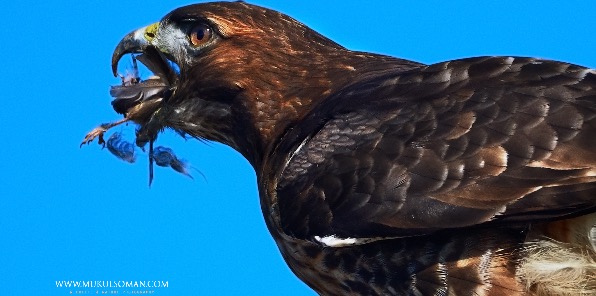
A mid-air duel between two old enemies.
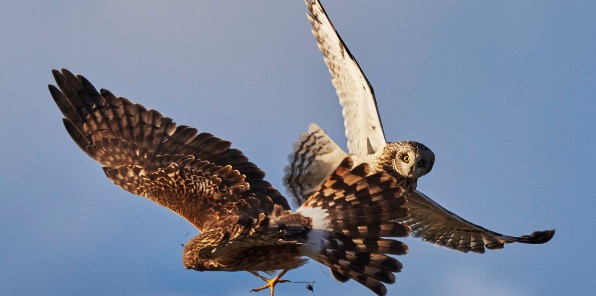
Short eared owls and Harrier hawks share habitats in most parts of their range across Washington state. They compete for food and territory and are not very tolerant of each other because of that.
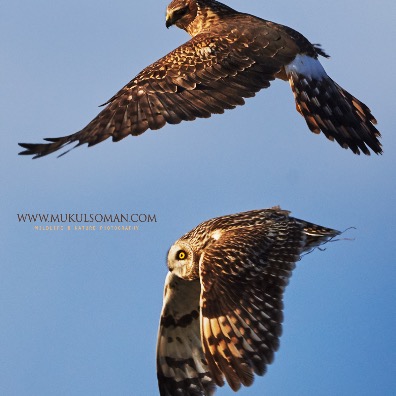
About the Author :
I am a Kirkland based Wildlife/Nature Photographer. I strive to blend together elements of documentary and fine art photography to bring compelling and evocative images to life. A delicate sensitivity towards the emotions of light and a great love for the wilderness and all creatures that inhabit those places are the foundations of my journey in photography. I want my photography to build awareness, inspire change and foster conservation of wildlife and the wildlands that they call home. Providing photographic education to nature lovers by enabling them to go out there and tell memorable tales though their photographs has been a great way to spread that message. I teach workshops and hold one-one photography mentor-ships at my own studio space in Seattle, along with my wife, who is a full time professional portrait photographer.
Special thanks to Mukul for contributing these inspiring words and photographs! If you would like to see more of Mukul’s work or learn more tricks of the trade, check out his website.
To see some of these amazing birds in action, please join us for Hawkwatching at Chelan RidgeSeptember 28-29!
See you there!







